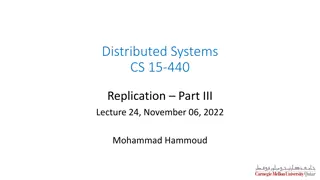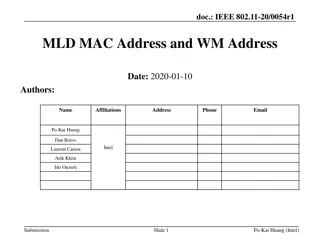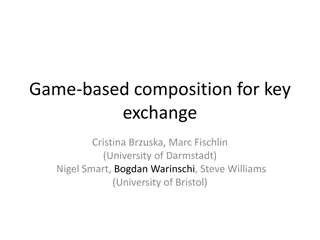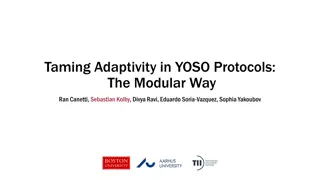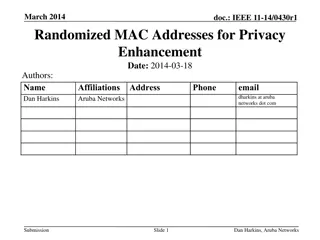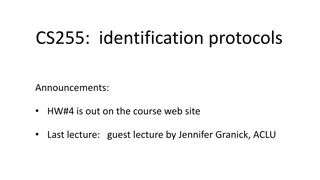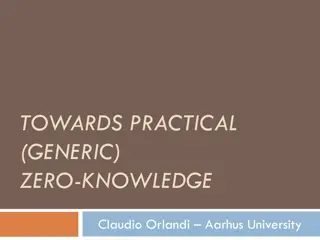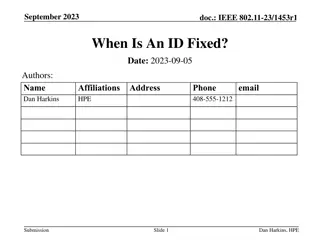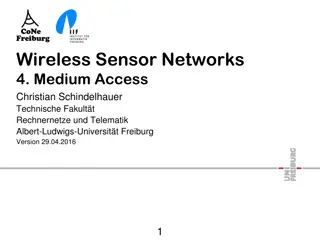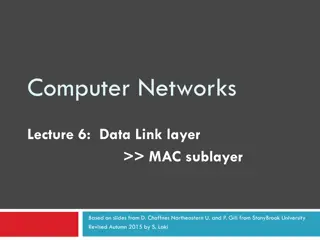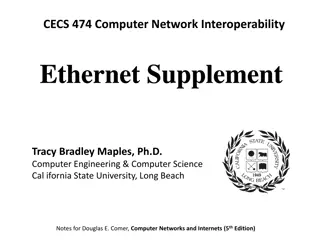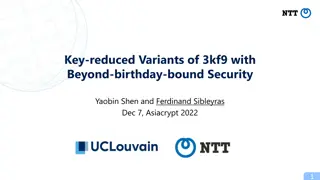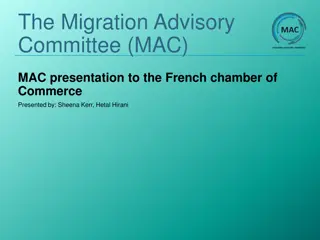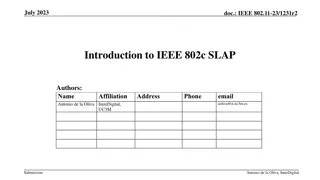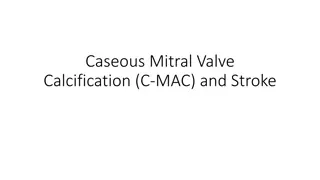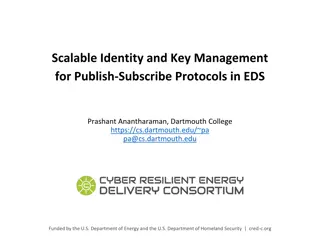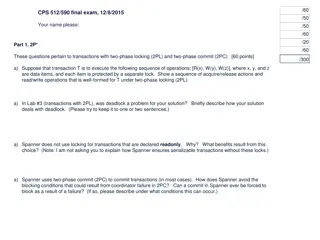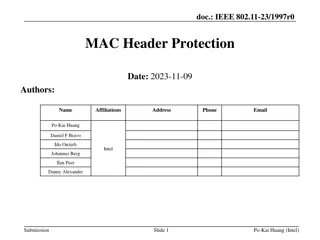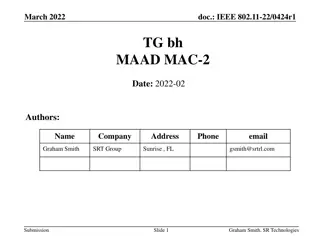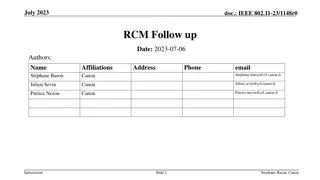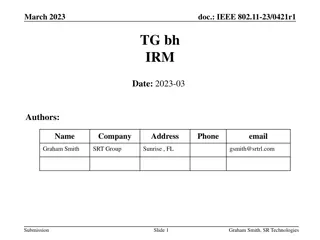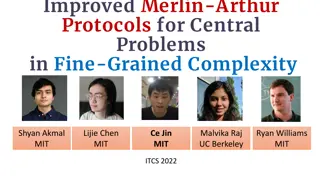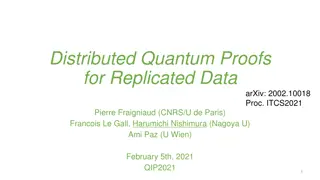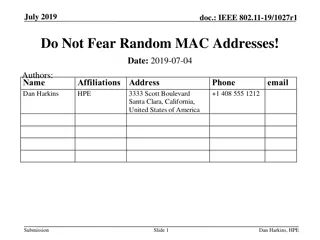Proposed Approach for MAC Address Assignment in IEEE 802.11
IEEE 802.1CQ is working on a mechanism to assign local MAC address blocks to end nodes specifically related to IEEE 802.11 standards. The current draft lacks a pre-association mechanism for IEEE 802.11 stations to obtain a local MAC address before association. The proposed remedy suggests specifying
6 views • 7 slides
Update on SWAG Protocols and New NICE TA Progress Report
Kate Gregory leads the SWAG Protocols update for March 2024, with advancements in new protocols and NICE TA updates. A comparison of activities from Oct 2023 to Mar 2024 shows progress in issuing, reviewing, and drafting protocols. The latest NICE TA additions include treatments for advanced cancers
5 views • 13 slides
Enhanced Security Considerations in IEEE 802.11-23 for UHR
The document discusses enhanced security considerations for control frames and MAC headers in IEEE 802.11-23 addressing vulnerabilities and proposing encryption/decryption methods. It highlights the need for support for security protocols in control frames and the importance of protecting MAC header
0 views • 13 slides
Understanding Consistency Protocols in Distributed Systems
Today's lecture covers consistency protocols in distributed systems, focusing on primary-based protocols and replicated-write protocols. These protocols play a crucial role in ensuring consistency across multiple replicas. One example discussed is the Remote-Write Protocol, which enforces strict con
0 views • 35 slides
IEEE 802.11-20/0054r1 MLD MAC Address and WM Address
In the document IEEE 802.11-20/0054r1, the focus is on Multi-Link Framework for MLD address identification and differentiation. It explains the usage of MLD MAC address and STA WM medium address in wireless setups. The document also addresses the need for identifying different MLDs using MAC address
0 views • 16 slides
IEEE Std. 802.11-22/1017r0 Overview and Architecture Presentation
This presentation by Dorothy Stanley from HP Enterprise delves into the utilization of IEEE Std. 802.11-2020 standards focusing on the IEEE Std. 802 overview and architecture. It covers topics such as the use of LLC, MAC address formats, QoS mechanisms, MSDU formats, and various MAC services and pro
0 views • 10 slides
Secure Composition of Key Exchange Protocols
Explore the game-based composition approach for key exchange protocols, focusing on ensuring security in compositions with arbitrary tasks and the universal composability of protocols. Delve into the Bellare-Rogaway security model and the details of security games in protocol analysis. Understand ke
0 views • 25 slides
Taming Adaptivity in YOSO Protocols: The Modular Way
Explore the concept of taming adaptivity in YOSO protocols through a modular approach. The research delves into the efficiency, adversary adaptivity, role assignments, and compiler models in synchronous YOSO protocols. The visual presentations illustrate the framework, challenges, and strategies in
0 views • 19 slides
Enhancing Privacy with Randomized MAC Addresses in 802.11 Networks
This presentation discusses the use of randomized MAC addresses as a privacy-enhancing measure in 802.11 networks. Passive observation of MAC addresses poses privacy risks, and the proposal suggests assigning random MAC addresses to portable devices to mitigate tracking risks. By periodically changi
0 views • 10 slides
Exploring DS Architecture Concepts in March 2015 IEEE Document
Delve into advanced DS architecture concepts discussed in the March 2015 IEEE document by Mark Hamilton from Spectralink. The document elaborates on the basic DS model, terminology like Portal DSAF, MAC service tuples, and distributed brains, offering insights into network structures and protocols.
0 views • 11 slides
Privacy Issues in IEEE 802.11 Networks: Tracking and MAC Randomization
This presentation delves into the privacy concerns surrounding 802.11 networks, focusing on tracking vulnerabilities and the limitations of MAC randomization in preventing tracking. It discusses the ease of tracking devices, the risk of passive tracking due to MAC addresses being visible in frames,
0 views • 27 slides
IEEE802.15-14-0110-01-0mag MAC Timing Discussion Points for IEEE 802.15.4 Revision
Initial discussion document submitted by Benjamin A. Rolfe from Blind Creek Associates addressing MAC timing issues in the IEEE 802.15.4 standard revision. The document identifies potential problems, provides a list of questions for consideration, and outlines areas for improvement. It includes stat
0 views • 8 slides
Overview of Identification Protocols in CS255 by Dan Boneh
The lecture in CS255 covers various topics related to identification protocols, including signatures from trapdoor functions, certificates, revocation methods, certificate issuance problems, defense mechanisms like certificate transparency (CT), and moving on to protocols. The talk also explores the
0 views • 43 slides
Towards Practical Generic Zero-Knowledge Protocols
Exploring the evolution of zero-knowledge protocols, this presentation by Claudio Orlandi from Aarhus University delves into the concepts of Zero-Knowledge from Garbled Circuits, Privacy-Free Garbled Circuits, and more. The talk discusses efficient methods for proving statements and touches on relat
0 views • 29 slides
Summary of MAC Address Policy Contribution to IEEE 802.11
This document outlines the contribution of MAC address policy to IEEE 802.11, focusing on defining ANQP and Beacon elements to convey information about addressing types supported by the network. It details how specific bits in the ANQP element represent support for various MAC address types includin
0 views • 5 slides
Implications of IEEE 802.11 State Machine and MAC Randomization
The document discusses the state machine transitions in IEEE 802.11, focusing on MAC address handling and implications for STA connectivity within an ESS. It explains the scenarios where a STA can use different MAC addresses, emphasizing the binding of state to specific address configurations and th
0 views • 11 slides
IEEE 802.11-21/1585r10: Identifiable Random MAC Address Presentation Summary
This presentation discusses the concept of Identifiable Random MAC (IRM) addresses in the IEEE 802.11-21/1585r10 standard. It covers the purpose of IRM addresses in preventing third-party tracking while allowing trusted parties to identify specific devices. The presentation outlines the use of Ident
0 views • 24 slides
Wireless Sensor Networks: Medium Access Protocols Overview
This collection of images presents key concepts in wireless sensor networks, focusing on medium access protocols, the ISO/OSI reference model, types of conflict resolution, contention-free protocols, Bitmap protocol, ALOHA algorithm, and its analysis and efficiency. Various protocols and algorithms
0 views • 83 slides
How to Record Your Voice: A Comprehensive Guide for Windows, Mac, and Smartphones
Learn how to record your voice for ePoster, MP3, or podcasts using Windows 10, Mac, Android, or iPhone/iPad devices. Find step-by-step instructions for recording on different platforms, including using Windows Voice Recorder on a Windows 10 computer and QuickTime Player on a Mac. Discover tips for a
1 views • 10 slides
Exploring Mac OS & VoiceOver: A Comprehensive Guide with Belinda Rudinger
Dive into the world of Mac OS and VoiceOver with expert Belinda Rudinger in this detailed tutorial. Learn about screen readers, VoiceOver commands, built-in features, interaction tools, customization options, and useful utilities. Discover how to navigate the Mac ecosystem seamlessly using VoiceOver
0 views • 20 slides
Green Protocols for Greener Arbitrations
The Green Protocols introduced by AtLAS aim to guide the arbitration community in committing to environmentally sustainable practices. These protocols suggest ways to reduce carbon emissions, energy consumption, waste generation, and unnecessary travel by utilizing electronic communication, video co
0 views • 14 slides
Understanding Dynamic Channel Allocation in Computer Networks
Exploring the Data Link Layer and MAC Sublayer in computer networks, focusing on dynamic channel allocation, station models, collision assumptions, continuous vs. slotted time, carrier sense mechanisms, efficiency measurements, throughput calculation, media access strategies like channel partitionin
0 views • 54 slides
Understanding Ethernet and Multiple Access Protocols in Computer Networks
Exploring the fundamentals of Ethernet and multiple access protocols in computer networks, this content discusses the two primary categories of multiple access protocols - contention access and controlled access. It delves into topics such as CSMA/CD, LANs, performance of multiple access schemes, ad
0 views • 7 slides
Understanding IP Routing and Switching in Computer Networks
In the world of computer networking, IP routing and switching play crucial roles in ensuring efficient data transmission. Switches make decisions based on MAC addresses, while routers route based on IP information. By managing routing tables and using static or dynamic routing protocols, networks ca
0 views • 13 slides
Lightweight Cryptography: Key-Reduced Variants and Beyond-Birthday-Bound Security
Lightweight cryptography has emerged as a hot research topic in the past two decades, with over 60 ciphers proposed. This includes examples like PRESENT, GIFT, SIMON/SPECK, and more. Authenticated encryption through CAESAR and NIST LWC plays a vital role, with ASCON and ACORN leading the lightweight
0 views • 25 slides
The Migration Advisory Committee Review and Findings
The Migration Advisory Committee (MAC) is an independent advisory body formed in 2007 to provide recommendations to the government on migration issues. The MAC does not create or implement policy but advises through research and analysis in various areas like economics, education, and stakeholder en
0 views • 13 slides
Local MAC Address Assignment Protocol (LAAP) and 802.1CQ
The Local MAC Address Assignment Protocol (LAAP) in conjunction with 802.1CQ specifies protocols and procedures for locally unique assignment of MAC addresses in IEEE 802 networks. LAAP operates in two modes - Server Mode and Peer-to-Peer Mode, ensuring efficient allocation of MAC addresses while av
0 views • 15 slides
Introduction to IEEE 802c SLAP
IEEE 802c defines Local Medium Access Control (MAC) Address Usage, providing structured approaches through the Structured Local Address Plan (SLAP) in different regions of the local MAC address space. Local MAC addresses are not globally unique, and the assignment is within local administration's sc
0 views • 9 slides
Caseous Mitral Valve Calcification (C-MAC) and Stroke: Overview and Management
Caseous Mitral Valve Calcification (C-MAC) is a rare condition characterized by spectrum liquefaction necrosis of the mitral annular calcification (MAC), potentially leading to cardiovascular complications like strokes and emboli. This article discusses the features, diagnostic aspects, and treatmen
0 views • 7 slides
Scalable Identity and Key Management for Publish-Subscribe Protocols
This research by Prashant Anantharaman from Dartmouth College focuses on scalable identity and key management for publish-subscribe protocols in Energy Delivery Systems. It discusses the architecture, goals, assumptions, and implementation results in the context of PKI vs. Macaroons protocols. The w
0 views • 37 slides
Comprehensive Examination Questions on Data Management Systems and Security Protocols
This content covers a range of topics related to data management systems, including two-phase locking and two-phase commit protocols, Bayou system with vector clocks and causality, digital signatures and certificates in protocols, and authentication protocols. Questions include scenarios and concept
0 views • 6 slides
Enhancing MAC Header Protection in IEEE 802.11 Networks
This document discusses the need for improved protection of MAC headers in IEEE 802.11 networks to address security concerns related to certain fields that are currently not adequately protected. It emphasizes the importance of safeguarding vital information in MAC headers to prevent potential attac
0 views • 12 slides
IEEE 802.11-22/0424r1 - MAAD MAC Protocol Overview
The document discusses the MAAD MAC protocol, where the AP assigns a MAAD MAC address to the STA during association. Key differences from other schemes are highlighted, emphasizing the use of MAAD MAC addresses as identification. Details on support indication, address allocation, and recognition mec
0 views • 7 slides
IEEE 802.11-22/0955r0 TGbh Pre-association Schemes Exploration
The document explores the pre-association schemes NGID, MAAD, and IRM within the IEEE 802.11-22 standard. It discusses how the schemes operate, comparing RRCM to MAAD and IRM, and addresses the use of Probes and MAC addresses in pre-association scenarios. The presentation clarifies the allocation of
0 views • 15 slides
RCM Procedure for Secure Parameter Obfuscation in IEEE 802.11 Networks
The document discusses the RCM procedure within IEEE 802.11 networks, focusing on obfuscating parameters like MAC addresses for enhanced security during CPE Client and CPE AP association. It outlines mechanisms for changing MAC addresses, SN, PN, AID, and TID without connection loss. The proposal su
0 views • 12 slides
IEEE 802.11-23/0421r1: Understanding the IRM Scheme for MAC Address Privacy
The document discusses the use of the Same MAC Address (SMA) scheme in IEEE 802.11-23/0421r1 and introduces the Improved Randomized MAC (IRM) scheme as a privacy-enhancing solution. It explores the implementation and benefits of IRM over SMA, addressing issues like privacy requirements, device ident
0 views • 7 slides
Improved Merlin-Arthur Protocols for Fine-Grained Complexity Problems
The text discusses Merlin-Arthur proof systems and protocols for central problems in fine-grained complexity, particularly focusing on the time complexity, completeness, and soundness of these protocols. It also touches on recent interest in these protocols and presents new results in areas such as
0 views • 16 slides
Quantum Distributed Proofs for Replicated Data
This research explores Quantum Distributed Computing protocols for tasks like leader election, Byzantine agreement, and more. It introduces Quantum dMA protocols for verifying equality of replicated data on a network without shared randomness. The study discusses the need for efficient protocols wit
0 views • 28 slides
Enhancement of Rule-based Random and Changing MAC Proposal in IEEE 802.11-22/1802r0
This document details the enhancements proposed for the Rule-based Random and Changing MAC (RRCM) in IEEE 802.11-22/1802r0. The RRCM concept involves generating Random MAC (RMA) addresses locally to increase security and prevent trackability in wireless networks. Key aspects include RMA generation,
0 views • 12 slides
MAC Address Randomization in IEEE 802.11: Privacy Concerns and Solutions
The document discusses the rise of MAC randomization in IEEE 802.11 networks, addressing motivations, benefits, concerns over privacy implications, and real-life scenarios highlighting the risks associated with passive observation of MAC addresses. It emphasizes the importance of safeguarding privac
0 views • 14 slides



